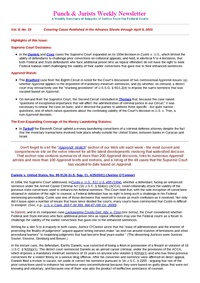Here the Court upheld a money laundering convictions of a criminal defense attorney despite the fact that the monetary transactions involved took place wholly outside the United States, between banks in Curacao and Israel.
The defendant in this case, a criminal defense lawyer, was convicted of conspiracy to commit money ...
Here, after the Supreme Court vacated the Eleventh Circuit's previous decision in this case in light of Apprendi, the Court held that such a remand did not require it to treat the case as though the Apprendi issue had been timely raised.
After the Eleventh Circuit's earlier unpublished decision in ...
On remand from the Supreme Court, the Second Circuit agreed to rehear this drug sentencing case en banc because of its "exceptional importance"; and it requested the parties to address three specific questions.
This brief per curiam order is phase two of one of the 49 convictions vacated to date ...
This case is noted for its discussion of two Apprendi issues: a) whether Apprendi requires the jury to determine the facts needed to impose a mandatory minimum; and b) whether, on a remand, the court can reimpose the same sentence by "stacking" sentences.
This is an interesting Apprendi decision because ...
This is the companion case to Daniels v. U.S., 532 U.S. 374 (2001) (both of which were decided on the same day by identical 5 to 4 margins). In both cases, the Court was faced with the question of whether Federal postconviction relief is available when a prisoner challenges a ...
In 1994, the Supreme Court addressed, in Custis v. U.S., 511 U.S. 485 (1994), whether a defendant, facing an enhanced sentence under the Armed Career Criminal Act (18 U.S.C. § 924(e)) (ACCA), could collaterally attack the validity of the previous state convictions used to enhance his federal sentence. The Court ...
